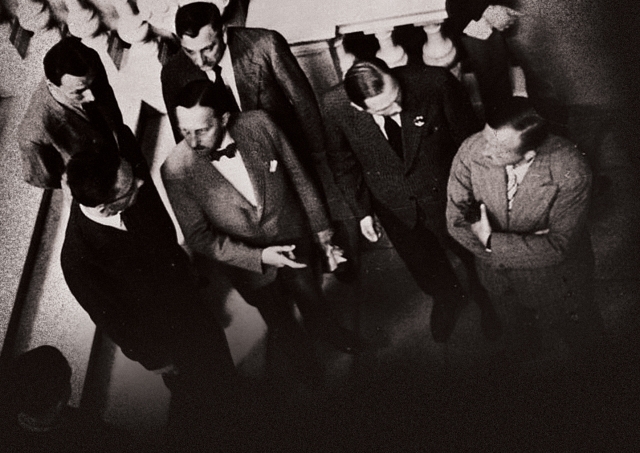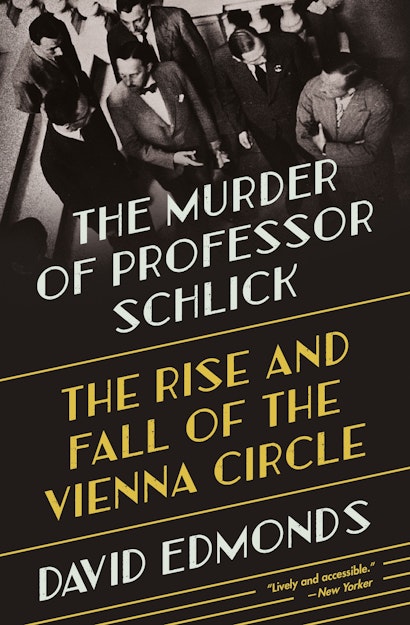Depending on how you look at it, the timing was either fortunate or ill-fated.
The Fifth International Congress for the Unity of Science met at Harvard from 3–9 September 1939. On 1 September 1939, German tanks had crossed into Poland: Britain and France had treaties with Poland guaranteeing its borders. Two days after the German invasion, Poland’s two Western allies responded by declaring war on Germany. The Congress opened, then, just as World War II began.
On the evening of the first day, the delegates listened to President Franklin D. Roosevelt’s radio address from the White House. He assured listeners that he did not intend the United States to become involved in hostilities. “I have said not once but many times that I have seen war and that I hate war. I say that again and again. I hope the United States will keep out of this war. I believe that it will. And I give you assurance and reassurance that every effort of your Government will be directed toward that end.”
Given the enormity of the events that were unfolding, a conference on the philosophy of science must have felt inconsequential, if not downright inappropriate. But for some of the participants, the staging of the conference that week was both lucky and life-changing—in fact, life-saving.
The scientist and philosopher Richard von Mises, whose brother was another renowned academic, the economist Ludwig von Mises, had traveled to Boston from Turkey. He did not go back. The Polish logician Alfred Tarski also stayed on, having embarked on the last ship to leave Poland before the German invasion. Apparently oblivious to the imminence of the threat to his homeland, he had the wrong visa (it was for a temporary visitor) and no winter clothing. Rather more important was that he was now cut off from his family in Warsaw. But had he not accepted the invitation to participate in the Congress, he would most likely have shared the fearful destiny of three million fellow Polish Jews.
Other speakers at this Harvard conference had left Europe in previous years. There to greet Tarski as he disembarked from the boat in New York was German-born philosopher Carl Gustav (Peter) Hempel. Hempel had been a student of the philosopher of science Hans Reichenbach, who had arrived in America in 1938 and was also present for the Congress. Rudolf Carnap, gentle in personality, colossal in stature—and about whom we’ll be hearing much more—had left for the US in December 1935. Philipp Frank, physicist and philosopher, had been based in the States for a year, after moving from Prague. Edgar Zilsel, considered a sociologist of science, had still been in Austria at the time of the Anschluss, the takeover of Austria by Germany in 1938, and was able to bring eyewitness testimony of the savagery the Nazis had unleashed. So too was the philosopher of law Felix Kaufmann. Because he had financial resources, Kaufmann had, naïvely, felt shielded from anti-Semitism, and left his escape until the last moment. Meanwhile, the most colorful character of them all, Otto Neurath, had arrived from The Hague, where he had recently taken up residence after fleeing Vienna in 1934. A contemporary Time magazine article painted him as a “bald, booming, energy-oozing sociologist and scientific philosopher.”1 Although his friends urged him to stay in the US, his immediate priority was to return to the Netherlands, and to the woman who would become his third wife.
In all there were some two hundred participants. The first sessions of the conference were focused on whether the sciences could be unified: What did the natural sciences, such as physics, have in common with the social sciences, such as psychology and sociology? Could they be placed on the same foundations, and how firm were these foundations? Beyond these issues, an eclectic range of other topics was discussed, including probability, truth, psychology, infinity, logic, the history and sociology of science, and the foundations of physics.
Much of the groundbreaking work in these areas had originated in Europe, specifically from Vienna. The conference had been organized by Neurath and Charles Morris, a Chicago-based philosopher with close links to the Vienna Circle and an enthusiast for bringing its ideas to the United States. American philosopher W.V.O. Quine wrote of the gathering in Harvard that it was basically “the Vienna Circle, with accretions, in international exile.”2 He himself was a vital accretion.
The Vienna Circle—and its so-called logical empiricism—had come to occupy a commanding position in the world of philosophy in general and in the philosophy of science in particular. The Circle had had a bold project. It had tried to marry an old empiricism with the new logic. It had wanted to carve out a role for philosophy in assisting science. It believed scientific propositions could be known and meaningful, and that this was what distinguished genuine propositions from pseudo-propositions; this was what demarcated science from metaphysics. It had included many brilliant thinkers, including Kurt Gödel, widely acknowledged to be the most significant logician of the twentieth century, and was linked to many others, including two of the most important philosophers of the twentieth century, Ludwig Wittgenstein and Karl Popper.
As the Harvard conference got under way, Europe was accelerating its descent into barbarity, with every day bringing acts of violence and cruelty that over the next six years would become routine. On 3 September, in the village of Truskolasy, in southern Poland, dozens of peasants were rounded up and shot. Just fifty miles away, twenty Jews were forced to assemble in the marketplace. Among them was sixty-four-year-old Israel Lewi. “When his daughter, Liebe, ran up to her father, a German told her to open her mouth for ‘impudence.’ He then fired a bullet into it.”3 The execution of each of the other Jews followed soon after. On the day the conference drew to a close, 630 Czech political prisoners were transported to Dachau concentration camp in Bavaria.
During the Harvard conference, a provocative position was adopted by Horace Kallen, a Jewish-American academic from the New School for Social Research who was famous for advocating cultural pluralism and for opposing what he regarded as oversimplified answers to philosophical problems. He advanced the view that attempting to unify the sciences was a dangerous project, linked to fascist ideology. Neurath, a distant relative of Kallen, countered that, on the contrary, unification had a democratic motivation, and would facilitate criticism of any particular specialism. Neurath was one of several Circle members who believed that logical empiricism was integral to the struggle against fascism. Logical empiricism represented Enlightenment values of reason and progress, a buffer against dark and irrational emotions. Logical empiricism represented sense against nonsense, truth against fiction. The fight was more important than ever.
Vienna had until recently been a creative cauldron. An unusual combination of political, social, and economic forces had somehow combined to produce astonishing cultural and scholarly achievements, including those of the Circle. Then the political cauldron had bubbled over. The Vienna Circle had been forcibly dissolved in 1934. Later, its leader, Moritz Schlick, was murdered.
Schlick’s killer, Johann Nelböck, a mentally unstable former student, claimed he was driven by political and ideological motives. Whether or not that was true—and it seems highly questionable—several Austrian newspapers took Nelböck at his word: logical empiricism was pernicious, antireligious, antimetaphysical. It was a Jewish philosophy, and Professor Schlick embodied all that was wrong with it. In this context, the argument ran, Nelböck’s act was not unreasonable. Indeed, one article suggested, it was even possible that Schlick’s death might facilitate the search for a solution to the “Jewish Question.”
Following Schlick’s murder the Vienna Circle continued to limp on informally. But the Anschluss and the outbreak of World War II marked points of no return. If its ideas were to survive, they would now have to take root in the Anglo-American world. That was a project for the future.
So what was the Vienna Circle, the “republic of scholars,”4 as Otto Neurath once described it, and why did it matter? Why had it been crushed by the authorities? Why had its members been forced into exile? And had it succeeded in its ultimate ambition—to vanquish metaphysics and banish the multiple varieties of pseudo-knowledge?
This essay is an excerpt from The Murder of Professor Schlick: The Rise and Fall of the Vienna Circle by David Edmonds.
About the Author
David Edmonds is the coauthor, with John Eidinow, of the bestselling Wittgenstein’s Poker as well as Rousseau’s Dog and Bobby Fischer Goes to War, and the author of Would You Kill the Fat Man? (Princeton). Cofounder, with Nigel Warburton, of the popular Philosophy Bites podcast series, he is a distinguished research fellow at the Oxford Uehiro Centre for Practical Ethics. Twitter @DavidEdmonds100
Notes
1. Quoted in Reisch, p. 72; originally from Time, 18 September, 1939, 72–73.
2. Quine, p. 140.
3. Gilbert, p. 4.
4. Quoted in Stadler (2001), p. 198.

